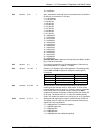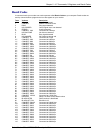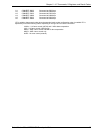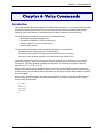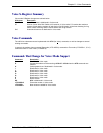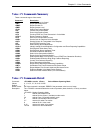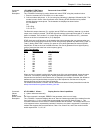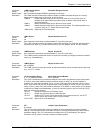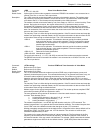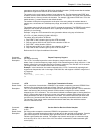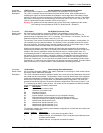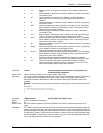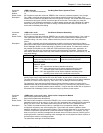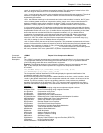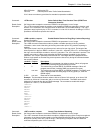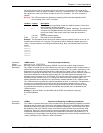
Chapter 6 – Voice Commands
SocketModem Global MT5634SMI Developer’s Guide 49
Command: +VRX Enter Voice Receive State
Values: 0, 1, 2–127, 128–255
Result Codes: Values (above) if the modem accepts the command; ERROR if the modem is not connected to an
off-hook Telco line, or one non-Telco input device.
Description: The +VRX command causes the modem to start the voice reception process. The modem starts
the process by returning the CONNECT result code to the PC. The modem then sends shielded
voice data to the PC, in the format previously selected by the +VSM command.
The modem exits the voice/receive state by one of two means: a <DLE><I>, and an Inactivity Timer
timeout. During the voice receive, the modem informs the PC of pertinent events, such as
Presumed End of Message (Quiet), and Presumed Hang Up (Silence) detected, Busy detected,
and Dial Tone detected, so that at the discretion of the PC, the PC may terminate the voice receive
state. On termination of the voice receive state, the modem returns the OK result code, and then
returns to the Voice Command state.
The Inactivity Timer is in effect during the receive operation. If the PC uses this timer and stops the
modem from performing unwanted restarts, the PC must assure that there is data sent from the PC
to the modem often enough to refresh the timer. The +VRX commands are as follows.
+VRX=0 Voice receive operation. This selection does not provide for modem periodical
tone production during a voice receive operation. The PC must issue the proper
notifications of a record operation in progress by message playbacks to satisfy
possible legal requirements.
+VRX=1 Voice receive operation. This selection does not provide for modem periodical
tone production during a voice-receive operation. The tone frequency and
cadence is manufacturer specific.
+VRX=2–127 Reserved for future specification.
+VRX=128–255 Manufacturer specific.
The result code values (0, 1, 2–127, 128–255) are returned if the modem accepts the command.
The ERROR result code is returned if the modem is not connected to an off-hook Telco line, or one
non-Telco input device.
Command: +VTS=<string> Produce DTMF and Tone Generation in Voice Mode
Values: Refer to the IS-101 Spec.
Default: Refer to the IS-101 Spec.
Result Codes: Refer to the IS-101 Spec.
Description: The +VTS command causes the modem to produce DTMF tones, single-frequency tones, and
optionally, double-frequency tones. This command allows the PC to generate a dial tone, busy, etc.
for those modems capable of generating two arbitrary tones. The modem may perform tone
detection during the playing of tones. When the modem receives the signal <DLE><!> to abort
playing of the tones, the result code OK is displayed, and the modem returns to the voice command
state.
The Inactivity Timer is in effect during the receive operation. If the PC uses this timer and stops the
modem from performing unwanted restarts, the PC must assure that there is data sent from the PC
to the modem often enough to refresh the timer.
Modem support for the second tone generation is optional. The modem produces compliant DTMF
tones when processing DTMF tone production codes.
The tone generation string consists of elements in a list where each element is separated by
commas. Each element can be:
1. A single ASCII character in the set of 0–9, #, *, and A–D
2. A string enclosed in square brackets [ ] , or
3. A string enclosed in curly braces { }
The modem interprets item 1 as a DTMF digit with duration set by the +VTD command. The
modem interprets item 2 as a general dual tone and duration selection. The modem interprets item
3 as a DTMF tone with a different duration than that given by the +VTD command.
Missing parameters are assumed to be the default value. Unspecified values always default to 0 for
frequencies, DTMF * for DTMF tones, and +VTD for duration. The omission of commas (and
associated subparameters) is valid.
The quantity in the square brackets consists of a three-element list. The first element is the first
frequency, the second element is the second frequency, and the third element is the duration, in
0.01second intervals. A list may contain null elements. For example, [3000] means that the modem
generates a single tone at 3000 Hz for the default duration. [3000,3300] means that the modem



